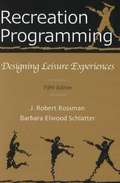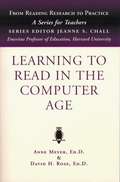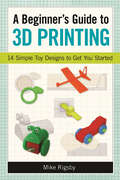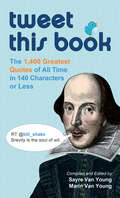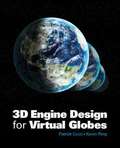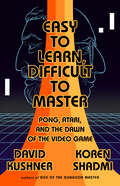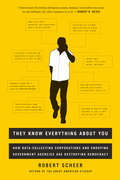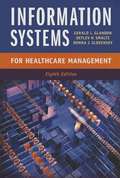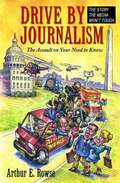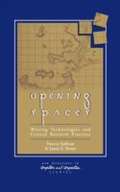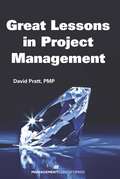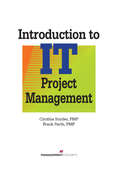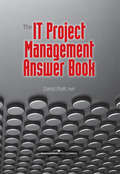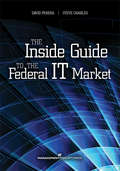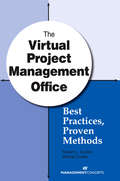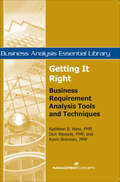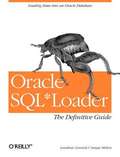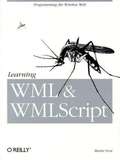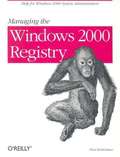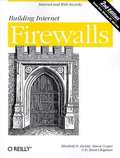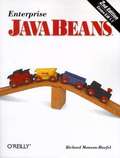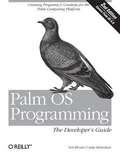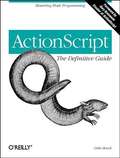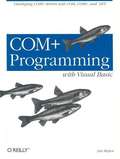- Table View
- List View
Recreation Programming
by J. Robert Roseman Barbara Elwood SchlatterUsed in numerous universities throughout the United States, Canada, Australia, and New Zealand, this book provides programming insights for educators, practitioners, and students. This book will present readers with the vital tools necessary in providing successful programs for their patrons.
Learning to Read in the Computer Age
by Anne Meyer David H. RoseThe computer and the Internet loom larger each year in the school lives of many children. This book acquaints the parent and teacher with the applicable computer function for a reading task and sample cutting edge software.
A Beginner's Guide to 3D Printing: 14 Simple Toy Designs to Get You Started
by Mike RigsbyA Beginner's Guide to 3D Printing is the perfect resource for those who would like to experiment with 3D design and manufacturing, but have little or no technical experience with the standard software. Author Mike Rigsby leads readers step-by-step through 15 simple toy projects, each illustrated with screen caps of Autodesk 123D Design, the most common free 3D software available. The projects are later described using Sketchup, another free popular software package. Beginning with basics projects that will take longer to print than design, readers are then given instruction on more advanced toys, including a baking-powder submarine, a train with expandable track, a multipiece airplane, a rubber band-powered car, and a noise-making push toy with froggy eyes. Once trained in the basics of computer-aided design, readers will be able to embark on even more elaborate projects of their own creation.
Tweet This Book: The 1,400 Greatest Quotes of All Time in 140 Characters or Less
by Sayre Van Young Marin Van YoungTHE TWITTER ANSWER TO YOUR FAVORITE QUOTATION DICTIONARY, WITH TWEETABLE-LENGTH QUOTES THAT ARE CLEVER, COOL, SMART, TOUCHING, WISE, FUNNY, AND MOREBrevity may be the soul of wit, but 140 characters is the absolute limit on Twitter! Luckily, Tweet This Book allows you to spice up their microblog with the greatest quotes of all time. Each one is not only brief - it is officially tweetable. The quick, punchy quotes in this wonderfully diverse collection come from all circles and include literary greats; politicians like Abe Lincoln, Winston Churchill, and Barack Obama; and sports figures, musicians, and celebrities like Yogi Berra, Tupac Shakur, and Hunter S. Thompson. With an easy-to-use, A-to-Z organization by topic, you can quickly find the perfect quote for anything you want to tweet about. "The only time to eat diet food is while you're waiting for the steak to cook."-Julia Child "Some cause happiness wherever they go; others whenever they go."-Oscar Wilde "Life is too short to blend in."-Paris Hilton "Whatever you are, be a good one."-Abraham Lincoln "Women need a reason to have sex. Men just need a place."-Billy Crystal
3D Engine Design for Virtual Globes
by Patrick Cozzi Kevin RingSupported with code examples and the authors’ real-world experience, this book offers the first guide to engine design and rendering algorithms for virtual globe applications like Google Earth and NASA World Wind. The content is also useful for general graphics and games, especially planet and massive-world engines. With pragmatic advice throughout, it is essential reading for practitioners, researchers, and hobbyists in these areas, and can be used as a text for a special topics course in computer graphics. Topics covered include: Rendering globes, planet-sized terrain, and vector data; Multithread resource management; Out-of-core algorithms; Shader-based renderer design.
Easy to Learn, Difficult to Master: Pong, Atari, and the Dawn of the Video Game
by David KushnerThe gripping origin story of Pong, Atari, and the digital icons who defined the world of video games.A deep, nostalgic dive into the advent of gaming, Easy to Learn, Difficult to Master returns us to the emerging culture of Silicon Valley. At the center of this graphic history, dynamically drawn in colors inspired by old computer screens, is the epic feud that raged between Atari founder Nolan Bushnell and inventor Ralph Baer for the title of &“father of the video game.&” While Baer, a Jewish immigrant whose family fled Germany for America, developed the first TV video-game console and ping-pong game in the 1960s, Bushnell, a self-taught whiz kid from Utah, put out Atari&’s pioneering table-tennis arcade game, Pong, in 1972. Thus, a prolonged battle began over who truly spearheaded the multibillion-dollar gaming industry, and around it a sweeping narrative about invention, inspiration, and the seeds of digital revolution.
They Know Everything About You: How Data-Collecting Corporations and Snooping Government Agencies Are Destroying Democracy
by Robert Scheer Sara BeladiThey Know Everything About You is a groundbreaking exposé of how government agencies and tech corporations monitor virtually every aspect of our lives, and a fierce defense of privacy and democracy. The revelation that the government has access to a vast trove of personal online data demonstrates that we already live in a surveillance society. But the erosion of privacy rights extends far beyond big government. Intelligence agencies such as the NSA and CIA are using Silicon Valley corporate partners as their data spies. Seemingly progressive tech companies are joining forces with snooping government agencies to create a brave new world of wired tyranny. Life in the digital age poses an unprecedented challenge to our constitutional liberties, which guarantee a wall of privacy between the individual and the government. The basic assumption of democracy requires the ability of the individual to experiment with ideas and associations within a protected zone, as secured by the Constitution. The unobserved moment embodies the most basic of human rights, yet it is being squandered in the name of national security and consumer convenience. Robert Scheer argues that the information revolution, while a source of public enlightenment, contains the seeds of freedom’s destruction in the form of a surveillance state that exceeds the wildest dream of the most ingenious dictator. The technology of surveillance, unless vigorously resisted, represents an existential threat to the liberation of the human spirit.
Information Systems for Healthcare Management (Eighth Edition)
by Gerald L. Glandon Detlev H. Smaltz Donna J. SlovenskyThis bestseller provides readers with the comprehensive knowledge necessary to understand healthcare information technology (HIT) and to hone their skills in HIT management. The book explores the areas where leaders must exhibit basic awareness or competency, including hardware, software, and communication systems; operational, management, and clinical applications; and selection, implementation, and valuation. <p><p> Each chapter has been updated to reflect current trends and challenges in the field as well as the implications of the 2010 healthcare reform law and other relevant federal mandates. Each chapter also features learning objectives, web resources, and discussion questions. This revised edition includes a glossary that clarifies technical terms as well as a list of abbreviations for important terms. Links to Internet sources are provided to supplement the information on the major topics covered in each chapter.
Drive-By Journalism: The Assault on Your Need to Know
by Arthur RowseA sobering look at the effect of mega-corporate media dominance; puts the lie to the myth of liberal bias in the mass media.
Opening Spaces: Writing Technologies and Critical Research Practices
by Patricia Sullivan James E. PorterThis book argues for a "post critical research methodology" and applies this frame to the study of computers and writing: the book opens a space where theoretical scholarship and empirical research can interact.
Great Lessons in Project Management
by David Pratt PmpLearn from Other Projects to Avoid Pitfalls on Your Projects!Projects fail at an alarming rate, whether they are information technology, training, construction, or policy development projects. No matter the focus, each year we experience an abundance of challenged projects that either require super-human effort to resuscitate or die an untimely death.Great Lessons in Project Management is a treasure trove of lessons learned from troubled projects—and from projects that went well. This collection of stories describes the events surrounding a particular challenge a project manager faced or a tool that another used effectively. Project managers of all types of projects can draw on these stories to validate their own good practices and to avoid the pitfalls so many have encountered on their projects.
Introduction to IT Project Management
by Cynthia Snyder Pmp Frank Parth PmpIntroduction to IT Project Management provides IT project managers the practical tools needed to maintain daily operations while managing multiple projects. This valuable reference helps IT project managers, CIOs, and project sponsors understand the IT project environment so that projects can be managed much more efficiently and successfully. An instructor's guide is available.
The IT Project Management Answer Book
by David Pratt PmpZero in on the answers to your IT project management questionsWith constrained schedules and anxious stakeholders eager for results, the typical IT project team doesn't have the luxury of wading through lengthy tomes to find solutions. The IT Project Management Answer Book guides you to the specific answers you need to successfully conduct and complete your IT project.Written in an easy-to-use question-and-answer format, the book covers all aspects of managing an IT project, from initial organizational issues to closeout. Following the classic project management processes, author David Pratt builds on the basics to offer valuable insights not found in other resources, including:• Proven techniques such as the best way to manage defects• How to create performance standards for outside contractors• How to develop a user's manualFor more technically inclined team members, the author's plain-speak approach presents a refreshing view of the IT world. For those less technically oriented, he describes the tools and solutions for dealing with IT project challenges in an accessible, straightforward way. Let this information-packed resource lead you and your team to IT project success.
The Inside Guide to the Federal IT Market
by David Perera Steve CharlesUnlock the Door to the Federal IT MarketplaceHere's your key to selling IT goods and services to the government. David Perera and Steve Charles present the ins and outs of successfully competing for—and winning—a share of the tens of billions of dollars the federal government spends each year on IT. Getting a piece of that business is not easy—it takes accurate knowledge of systems and procedures, as well as sharp insight into the structure and details of government procurement.The Inside Guide to the Federal IT Market penetrates the haze of jargon and apparent complexity to reveal the inner workings of the IT contracting process. Whether you're just setting out or seek a bigger share, this comprehensive book provides valuable information you can put to immediate use. The Inside Guide to the Federal IT Market covers:• Technology standards• Basic contracting concepts• Advanced contracting concepts, such as getting on and staying on the GSA schedules• The effect of the federal budget process on the sales cycle• What you need to know about ethics to earn business fairly, without avoidable delays and hassleThis book's focus on the IT market makes it a unique reference on federal procurement for private companies. Government procurement personnel will also find the depth and breadth of coverage useful in reviewing and evaluating IT offerings.
The Virtual Project Management Office: Best Practices, Proven Methods
by Robert L. Gordon DM Wanda Curlee DM, PMP, PgMP, PMI-RMPSuccessfully Launch and Operate a Virtual Project Management OfficeNew technology and global businesses and organizations are making virtual project management offices (VPMOs) more important and more prevalent than ever. Successfully operating a VPMO requires project managers to employ additional skills and address different challenges from those necessary to operate a traditional PMO. For example, the virtual project manager must have effective soft skills to build trust among a dispersed team and to select the best forms of communication. He or she must also ensure compliance with the unique policies, procedures, and laws relevant to maintaining a VPMO.This book offers best practices for successful virtual projects and the most effective ways to create and implement a PMO in a virtual environment. It's a valuable resource for companies considering a VPMO and those already operating one.You'll find:- Proven implementation plans- Guidance for building a business case- Laws and ethics governing VPMOs- Tips and advice from expertsPlus! Dozens of practical tools to use in launching a VPMO or improving an existing project management office.
Getting It Right: Business Requirement Analysis Tools and Techniques
by Kevin Brennan Don Wessels Kathleen B HassVolume of the Business Analysis Essential Library SeriesGetting It Right: Business Requirement Analysis Tools and Techniques, presents principles and practices for effective requirements analysis and specification, and a broad overview of the requirements analysis and specification processes. This critical reference is designed to help the business analyst decide which requirement artifacts should be produced to adequately analyze requirements. Examine the complete spectrum of business requirement analysis from preparation through documentation. Learn the steps in the analysis and specification process, as well as, how to choose the right requirements analysis techniques for your project.
Oracle SQL*Loader: The Definitive Guide
by Jonathan Gennick Sanjay MishraDespite the wide availability and use of SQL*Loader, few Oracle DBAs and developers know how powerful it really is. This book describes all of SQL*Loader's functions, including how to construct the necessary control files, load different types of data, and get the best performance. It covers the newest SQL*Loader features--the loading of large object (LOB) columns and the new object types (nested tables, varying arrays, and object tables).
Learning WML & WMLScript
by Martin FrostThe next generation of mobile communicators is here, and delivering content to them will mean programming in WML (Wireless Markup Language) and WMLScript, the languages of the Wireless Application Environment (WAE). The WAE allows information in almost all applications to be formatted for display on mobile devices, such as cell phones, and enables the user to interact with the information. Why learn yet another technology? According to some estimates, 75 percent of web document viewing by the year 2002 will be through non-desktop devices, many using wireless technologies. Clearly, the future is wireless. For web developers who want to get up to speed quickly in these languages, Learning WML & WMLScript maps out in detail the WAE and its two major components, WML and WMLScript. Fortunately, the WAE provides a World Wide Web-like model for writing applications, incorporating several key features of the Web to ease the transition for developers. Almost all wireless applications can be written with WML, which replaces HTML in the wireless environment, and WMLScript, which replaces JavaScript. With this book, web developers with some knowledge of programming and C, Java, or JavaScript syntax can easily master both languages. Chapter by chapter, Learning WML & WMLScript takes readers through the following WML topics: *Decks, templates and cards *User Interaction *Variables and contexts *Tasks, events, and timers *Text and text formatting *Data types, conversions and variables *Operators and expressions *Statements *Functions *Standard libraries. WMLScript topics include: Learning WML & WMLScript is the resource of choice for application developers who want to upgrade their skills and their sites so they won't be left plugged in during the wireless revolution.
Managing the Windows 2000 Registry
by Paul RobichauxThe Windows 2000 Registry is the repository for all hardware, software, and application configuration settings. Managing the Windows 2000 Registry is the system administrator's guide to maintaining, monitoring, and updating the Registry database. A "must-have" for every 2000 system manager or administrator, it covers what the Registry is and where it lives on disk, available tools, Registry access from programs, and Registry content.
Building Internet Firewalls, 2nd Edition
by D. Brent Chapman Simon Cooper Elizabeth D. ZwickyCompletely revised and much expanded, the new edition of the highly respected and bestselling Building Internet Firewalls now covers Unix, Linux, and Windows NT. This practical and detailed guide explains in step-by-step fashion how to design and install firewalls and configure Internet services to work with a firewall. It covers a wide range of services and protocols and offers a complete list of resources, including the location of many publicly available firewalls construction tools.
Enterprise JavaBeans, 2nd Edition
by Richard Monson-HaefelEnterprise JavaBeans (versions 1.1 and 1.0) is an important technology for server-side application development in Java. It offers a component architecture for developing distributed, multitiered enterprise applications. This model allows you to build complex, mission-critical systems using simple snap-together pieces that model individual business objects and processes. Enterprise JavaBeans (EJB) greatly simplifies the process of development by automatically taking care of system issues like object persistence and transaction management. This book provides a thorough introduction to EJB 1.1 and 1.0 for the enterprise software developer. It shows you how to develop enterprise Beans to model your business objects and processes. One powerful advantage of the EJB architecture is that it allows you to partition work appropriately between different parts of the system: the database provides persistence, your Beans model various business entities and the interactions between them, and your client application provides a user interface, but incorporates minimal business logic. The end result is a highly flexible system built from components that can easily be reused, and that can be changed to suit your needs without upsetting other parts of the system. Enterprise JavaBeans, 2nd Edition teaches you how to take advantage of the flexibility and simplicity that this powerful new architecture provides. This book covers: Enterprise JavaBeans 1.1 and 1.0 Developing entity Beans and session Beans XML Deployment Descriptors Using the client-side API to use enterprise Beans Transaction Management Design Strategies Introduction to J2EE
Palm OS Programming: The Developer's Guide, 2nd Edition
by Julie Mckeehan Neil RhodesPalm OS Programming: The Developer's Guide , Second Edition shows intermediate to experienced C and C++ programmers how to build a Palm application from the ground up. The book follows up the success of our best-selling first edition with expanded coverage of the Palm OS, up to and including the latest version, 4.0. This book will set the standard for the next generation of Palm developers.
ActionScript: The Definitive Guide
by Colin MoockGiven its ability to deliver high-impact experiences even over low-bandwidth connections, Flash has become the de facto standard for hundreds of thousands of multimedia web developers worldwide. Flash 5 now includes a new full-fledged programming language called "ActionScript" for controlling animation and multimedia. It's a quantum leap from the bare-bones "Actions" supported in Flash 4, and ActionScript: The Definitive Guide is the first book dedicated entirely to documenting and demonstrating this new language. ActionScript includes all fundamental programming constructs (variables, loops, conditionals, functions, etc.), and is inextricably fused with Flash's authoring behaviors and animation timelines. Because ActionScript is based heavily on the ECMAScript Language Specification (ECMA-262) and is syntactically nearly identical to JavaScript, Macromedia expects thousands of existing JavaScript programmers to migrate to ActionScript. This book is divided into three sections. "ActionScript Fundamentals" introduces both programmers and non-programmers to the new language by first describing fundamental programming concepts and then delineating in detail the components, syntax, and usage of ActionScript. "Applied ActionScript Code Depot" shows you how to use common applications, such as processing online forms. "Language Reference" is a concise and detailed reference that makes all ActionScript globals, properties, and objects, including extensive implementation samples, easy to find quickly. Step-by-step tutorials of the most common ActionScript behaviors Object-oriented programming in Flash Intelligent interface development Server communication Dynamic content generation Password protection String handling Message boards Basic physics Games Code samples are also available from the "Code Depot" on the author's web site devoted to Flash developers. Topics covered in this book include: ActionScript: The Definitive Guide is structured so both programmers and non-programmers can learn how to use ActionScript. This book will take you well beyond simple Flash animations so you can create your own enhanced Flash-driven sites.
COM+ Programming with Visual Basic
by Jose MojicaThe importance of a book like COM+ Programming with Visual Basic lies in the fact that the Visual Basic programming environment is designed to hide as many low-level system details as possible. While this approach can speed development time by letting you focus on the task at hand, it actually hinders the process when it obscures details you need to understand or control. Such is often the case for programmers who are developing components that take advantage of COM+ services. COM+ Programming with Visual Basic takes aim squarely at the information needs of these developers. For instance, despite the marketing hype about COM+ as the new and improved version of COM, classic COM is very much the foundation on which COM+ is built: COM+ components are a particular kind of COM component. Visual Basic hides almost all COM implementation details; yet it is precisely in the area of COM+ programming that these hidden details are most important. Therefore, we've devoted significant content to exploring COM internals: Interface-based programming How COM interfaces work internally How COM components are activated How versioning COM components works in Visual Basic How to use interfaces Passing objects by reference or by value What it means to have multithreaded applications How declarative programming works How to program within a distributed transaction How to add role-based security to applications The second section focuses on incorporating individual COM+ services, like transaction support, security, and asynchronous operations, into applications. The author concludes by discussing what you need to learn to transition to Microsoft's coming .NET framework. Regardless of what lies ahead for .NET, many distributed systems are being built today with COM+. COM+ Programming with Visual Basic focuses on topics relevant to distributed applications that are here to stay: There's simply no other documentation available for much of what's in COM+ Programming with Visual Basic. It's destined to be the resource behind the most robust, efficient, high-performance COM+ applications.
